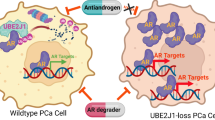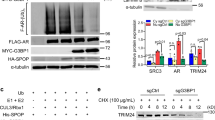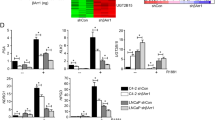Abstract
The androgen receptor (AR) plays a crucial role in the modulation of prostate cell proliferation and is involved in the development and progression of prostate cancer (PCa). An understanding of the complex regulation of AR provides novel treatment options for PCa. Here, we show (i) that the ubiquitin-like modifier, interferon-stimulated gene 15 (ISG15), and most enzymes involved in ISG15 conjugation were upregulated in tumor samples versus in non-malignant tissues of PCa patients and (ii) that the expression of these components significantly differed between tumors in patients treated with and without androgen ablation. Using PCa cell lines as in vitro models, the specific androgen-mediated, AR-dependent regulation of the ISGylation components was confirmed. In addition, the ISGylation system controls AR mRNA and protein expressions, as overexpression of Ube1L as a limiting ISGylation factor in the AR+ androgen-sensitive PCa cell line, LNCaP, results in significant AR upregulation, accompanied by an increased proliferation even under androgen deprivation. Accordingly, Ube1L knockdown decreased the AR expression. Thus, this study describes for the first time the modulation of AR expression by ISGylation components, which affects the proliferation of PCa cells, thereby providing evidence for a novel function of the ISGylation system in malignant transformation.
This is a preview of subscription content, access via your institution
Access options
Subscribe to this journal
Receive 50 print issues and online access
$259.00 per year
only $5.18 per issue
Buy this article
- Purchase on Springer Link
- Instant access to full article PDF
Prices may be subject to local taxes which are calculated during checkout








Similar content being viewed by others
References
Andersen JB, Aaboe M, Borden EC, Goloubeva OG, Hassel BA, Orntoft TF . (2006). Stage-associated overexpression of the ubiquitin-like protein, ISG15, in bladder cancer. Br J Cancer 94: 1465–1471.
Andersen JB, Hassel BA . (2006). The interferon regulated ubiquitin-like protein, ISG15, in tumorigenesis: friend or foe? Cytokine Growth Factor Rev 17: 411–421.
Asirvatham AJ, Schmidt M, Gao B, Chaudhary J . (2006). Androgens regulate the immune/inflammatory response and cell survival pathways in rat ventral prostate epithelial cells. Endocrinol 147: 257–271.
Basrawala Z, Alimirah F, Xin H, Mohideen N, Campbell SC, Flanigan RC et al. (2006). Androgen receptor levels are increased by interferons in human prostate stromal and epithelial cells. Oncogene 25: 2812–2817.
Bektas N, Noetzel E, Veeck J, Press MF, Kristiansen G, Naami A et al. (2008). The ubiquitin-like molecule interferon-stimulated gene 15 (ISG15) is a potential prognostic marker in human breast cancer. Breast Cancer Res 10: R58.
Berger R, Febbo PG, Majumder PK, Zhao JJ, Mukherjee S, Signoretti S et al. (2004). Androgen-induced differentiation and tumorigenicity of human prostate epithelial cells. Cancer Res 64: 8867–8875.
Van Bokhoven A, Varella-Garcia M, Korch C, Johannes WU, Smith EE, Miller HL et al. (2003). Molecular characterization of human prostate carcinoma cell lines. Prostate 57: 205–225.
Borden EC, Lindner D, Dreicer R, Hussein M, Peereboom D . (2000). Second-generation interferons for cancer: clinical targets. Semin Cancer Biol 10: 125–144.
Callewaert L, Verrijdt G, Haelens A, Claessens F . (2004). Differential effect of small ubiquitin-like modifier (SUMO)-ylation of the androgen receptor in the control of cooperativity on selective versus canonical response elements. Mol Endocrinol 18: 1438–1449.
Chen CD, Welsbie DS, Tran C, Baek SH, Chen R, Vessella R et al. (2004). Molecular determinants of resistance to antiandrogen therapy. Nat Med 10: 33–39.
Craft N, Shostak Y, Carey M, Sawyers CL . (1999). A mechanism for hormone-independent prostate cancer through modulation of androgen receptor signaling by the HER-2/neu tyrosine kinase. Nat Med 5: 280–285.
Culig Z, Hobisch A, Herold M, Hittmair A, Thurnher M, Eder IE et al. (1998). Interleukin 1beta mediates the modulatory effects of monocytes on LNCaP human prostate cancer cells. Br J Cancer 78: 1004–1011.
Dastur A, Beaudenon S, Kelley M, Krug RM, Huibregtse JM . (2006). Herc5, an interferon-induced HECT E3 enzyme, is required for conjugation of ISG15 in human cells. J Biol Chem 281: 4334–4338.
Desai KV, Michalowska AM, Kondaiah P, Ward JM, Shih JH, Green JE . (2004). Gene expression profiling identifies a unique androgen-mediated inflammatory/immune signature and a PTEN (phosphatase and tensin homolog deleted on chromosome 10)-mediated apoptotic response specific to the rat ventral prostate. Mol Endocrinol 18: 2895–2907.
Desai SD, Haas AL, Wood LM, Tsai YC, Pestka S, Rubin EH et al. (2006). Elevated expression of ISG15 in tumor cells interferes with the ubiquitin/26S proteasome pathway. Cancer Res 66: 921–928.
Desai SD, Wood LM, Tsai YC, Hsieh TS, Marks JR, Scott GL et al. (2008). ISG15 as a novel tumor biomarker for drug sensitivity. Mol Cancer Ther 7: 1430–1439.
Edwards J, Krishna NS, Grigor KM, Bartlett JM . (2003). Androgen receptor gene amplification and protein expression in hormone refractory prostate cancer. Br J Cancer 89: 552–556.
Feng Q, Sekula D, Guo Y, Liu X, Black CC, Galimberti F et al. (2008). UBE1L causes lung cancer growth suppression by targeting cyclin D1. Mol Cancer Ther 7: 3780–3788.
Giannakopoulos NV, Luo JK, Papov V, Zou W, Lenschow DJ, Jacobs BS et al. (2005). Proteomic identification of proteins conjugated to ISG15 in mouse and human cells. Biochem Biophys Res Commun 336: 496–506.
Gioeli D, Ficarro SB, Kwiek JJ, Aaronson D, Hancock M, Catling AD et al. (2002). Androgen receptor phosphorylation. Regulation and identification of phosphorylation sites. J Biol Chem 277: 29304–29314.
Gong Y, Blok LJ, Perry JE, Lindzey JK, Tindall DJ . (1995). Calcium regulation of androgen receptor expression in the human prostate cancer cell line LNCaP. Endocrinology 136: 2172–2178.
Gregory CW, He B, Johnson RT, Ford OH, Mohler JL, French FS et al. (2001b). A mechanism for androgen receptor-mediated prostate cancer recurrence after androgen-deprivation therapy. Cancer Res 61: 4315–4319.
Gregory CW, Johnson Jr RT, Mohler JL, French FS, Wilson EM . (2001a). Androgen receptor stabilization in recurrent prostate cancer is associated with hypersensitivity to low androgen. Cancer Res 61: 2892–2898.
Heemers HV, Tindall DJ . (2007). Androgen receptor (AR) coregulators: a diversity of functions converging on and regulating the AR transcriptional complex. Endocr Rev 28: 778–808.
Iacobuzio-Donahue CA, Maitra A, Olsen M, Lowe AW, van Heek NT, Rosty C et al. (2003). Exploration of global gene expression patterns in pancreatic adenocarcinoma using cDNA microarrays. Am J Pathol 162: 1151–1162.
Ikeda K, Orimo A, Higashi Y, Muramatsu M, Inoue S . (2000). Efp as a primary estrogen-responsive gene in human breast cancer. FEBS Lett 472: 9–13.
Jemal A, Siegel R, Ward E, Hao Y, Xu J, Murray T et al. (2008). Cancer statistics, 2008. CA Cancer J Clin 58: 71–96.
Jung D, Hilmes C, Knuth A, Jaeger E, Huber C, Seliger B . (1999). Gene transfer of the Co-stimulatory molecules B7-1 and B7-2 enhances the immunogenicity of human renal cell carcinoma to a different extent. Scand J Immunol 50: 242–249.
Kalvakolanu DV . (2000). Interferons and cell growth control. Histol Histopathol 15: 523–537.
Kim KI, Giannakopoulos NV, Virgin HW, Zhang DE . (2004). Interferon-inducible ubiquitin E2, Ubc8, is a conjugating enzyme for protein ISGylation. Mol Cell Biol 24: 9592–9600.
Khodarev NN, Minn AJ, Efimova EV, Darga TE, Labay E, Beckett M et al. (2007). Signal transducer and activator of transcription 1 regulates both cytotoxic and prosurvival functions in tumor cells. Cancer Res 67: 9214–9220.
Ko S, Shi L, Kim S, Song CS, Chatterjee B . (2008). Interplay of nuclear factor-kappaB and B-myb in the negative regulation of androgen receptor expression by tumor necrosis factor alpha. Mol Endocrinol 22: 273–286.
Korant BD, Blomstrom DC, Jonak GJ, Knight Jr E . (1984). Interferon-induced proteins. Purification and characterization of a 15 000-dalton protein from human and bovine cells induced by interferon. J Biol Chem 259: 14835–14839.
Li R, Wheeler T, Dai H, Frolov A, Thompson T, Ayala G . (2004). High level of androgen receptor is associated with aggressive clinicopathologic features and decreased biochemical recurrence-free survival in prostate: cancer patients treated with radical prostatectomy. Am J Surg Pathol 28: 928–934.
Lin DL, Whitney MC, Yao Z, Keller ET . (2001). Interleukin-6 induces androgen responsiveness in prostate cancer cells through up-regulation of androgen receptor expression. Clin Cancer Res 7: 1773–1781.
Linja MJ, Savinainen KJ, Saramäki OR, Tammela TL, Vessella RL, Visakorpi T . (2001). Amplification and overexpression of androgen receptor gene in hormone-refractory prostate cancer. Cancer Res 61: 3550–3555.
Liu M, Hummer BT, Li X, Hassel BA . (2004). Camptothecin induces the ubiquitin-like protein, ISG15, and enhances ISG15 conjugation in response to interferon. J Interferon Cytokine Res 24: 647–654.
Maggiolini M, Recchia AG, Carpino A, Vivacqua A, Fasanella G, Rago V et al. (2004). Oestrogen receptor beta is required for androgen-stimulated proliferation of LNCaP prostate cancer cells. Mol Endocrinol 32: 777–791.
Malakhov MP, Kim KI, Malakhova OA, Jacobs BS, Borden EC, Zhang DE. (2003). High-throughput immunoblotting. Ubiquitin-like protein ISG15 modifies key regulators of signal transduction. J Biol Chem 278: 16608–16613.
Malakhova OA, Zhang DE . (2008). ISG15 inhibits Nedd4 ubiquitin E3 activity and enhances the innate antiviral response. J Biol Chem 283: 8783–8787.
Mitsui K, Nakanisha M, Ohtsuka S, Norwood TH, Okabayashi K, Miyamoto C et al. (1999). A novel human gene encoding HECT domain and RCC1-like repeats interacts with cyclins and is potentially regulated by the tumor suppressor proteins. Biochem Biophys Res Commun 266: 115–122.
Nakajima A, Maruyama S, Bohgaki M, Miyajima N, Tsukiyama T, Sakuragi N et al. (2007). Ligand-dependent transcription of estrogen receptor alpha is mediated by the ubiquitin ligase EFP. Biochem Biophys Res Commun 357: 245–251.
Nantermet PV, Xu J, Yu Y, Hodor P, Holder D, Adamski S et al. (2004). Identification of genetic pathways activated by the androgen receptor during the induction of proliferation in the ventral prostate gland. J Biol Chem 279: 1310–1322.
Okumura F, Zou W, Zhang DE . (2007). ISG15 modification of the eIF4E cognate 4EHP enhances cap structure-binding activity of 4EHP. Genes Dev 21: 255–260.
Olshavsky NA, Groh EM, Comstock CE, Morey LM, Wang Y, Revelo MP et al. (2008). Cyclin D3 action in androgen receptor regulation and prostate cancer. Oncogene 27: 3111–3121.
Pitterle DM, Jolicoeur EM, Bepler G . (1998). Hot spots for molecular genetic alternations in lung cancer. In vivo 12: 643–658.
Polyak K, Xia Y, Zweier JL, Kinzler KW, Vogelstein B . (1997). A model for p53-induced apoptosis. Nature 389: 300–305.
Reddy GP, Barrack ER, Dou QP, Menon M, Pelley R, Sarkar FH et al. (2006). Regulatory processes affecting androgen receptor expression, stability, and function: potential targets to treat hormone-refractory prostate cancer. J Cell Biochem 98: 1408–1423.
Rokhlin OW, Taghiyev AF, Guseva NV, Glover RA, Chumakov PM, Kravchenko JE et al. (2005). Androgen regulates apoptosis induced by TNFR family ligands via multiple signalling pathways in LNCaP. Oncogene 24: 6773–6784.
Sakuma M, Akahira J, Suzuki T, Inoue S, Ito K, Moriya T et al. (2005). Expression of estrogen-responsive finger protein (Efp) is associated with advanced disease in human epithelial ovarian cancer. Gynecol Oncol 99: 664–670.
Sica G, Dell’Acqua G, Iacopino F, Fattorossi A, Marchetti P, van der Kwast TH et al. (1994). Androgen receptors and hormone sensitivity of a human prostatic cancer cell line (PC-3) are modulated by natural β-interferon. Urol Res 22: 33–38.
Stanbrough M, Leav I, Kwan PW, Bubley GJ, Balk SP . (2001). Prostatic intraepithelial neoplasia in mice expressing an androgen receptor transgene in prostate epithelium. Proc Natl Acad Sci USA 98: 10823–10828.
Suzuki T, Urano T, Tsukui T, Horie-Inoue K, Moriya T, Ishida T et al. (2005). Estrogen-responsive finger protein as a new potential biomarker for breast cancer. Clin Cancer Res 11: 6148–6154.
Takahashi Y, Perkins SN, Hursting SD, Wang TTY . (2007). 17β-estradiol differentially regulates androgen-responsive genes through estrogen receptor-β- and extracellular-signal regulated kinase-dependent pathways in LNCaP human prostate cancer cells. Mol Carcinog 46: 117–129.
Takeuchi T, Iwahara S, Saeki Y, Sasajima H, Yokosawa H . (2005). Link between the ubiquitin conjugation system and the ISG15 conjugation system: ISG15 conjugation to the UbcH6 ubiquitin E2 enzyme. J Biochem (Tokyo) 138: 711–719.
Takeuchi T, Kobayashi T, Tamura S, Yokosawa H . (2006). Negative regulation of protein phosphatase 2Cbeta by ISG15 conjugation. FEBS Lett 580: 4521–4526.
Takeuchi T, Yokosawa H . (2005). ISG15 modification of Ubc13 suppresses its ubiquitin-conjugating activity. Biochem Biophys Res Commun 336: 9–13.
Taplin ME, Balk SP . (2004). Androgen receptor: a key molecule in the progression of prostate cancer to hormone independence. J Cell Biol 91: 483–490.
Weichselbaum RR, Ishwaran H, Yoon T, Nuyten DS, Baker SW, Khodarev N et al. (2008). An interferon-related gene signature for DNA damage resistance is a predictive marker for chemotherapy and radiation for breast cancer. Proc Natl Acad Sci USA 105: 18490–18495.
Yeap BB, Krueger RG, Leedman PJ . (1999). Differential posttranscriptional regulation of androgen receptor gene expression by androgen in prostate and breast cancer cells. Endocrinology 140: 3282–3291.
Yuan W, Krug RM . (2001). Influenza B virus NS1 protein inhibits conjugation of the interferon (IFN)-induced ubiquitin-like ISG15 protein. EMBO J 20: 362–371.
Zhao C, Beaudenon SL, Kelley ML, Waddell MB, Yuan W, Schulman BA et al. (2004). The UbcH8 ubiquitin E2 enzyme is also the E2 enzyme for ISG15, an IFN-alpha/beta-induced ubiquitin-like protein. Proc Natl Acad Sci USA 101: 7578–7582.
Zhao C, Denison C, Huibregtse JM, Gygi S, Krug RM . (2005). Human ISG15 conjugation targets both IFN-induced and constitutively expressed proteins functioning in diverse cellular pathways. Proc Natl Acad Sci USA 102: 10200–10205.
Zou W, Wang J, Zhang DE . (2007). Negative regulation of ISG15 E3 ligase EFP through its autoISGylation. Biochem Biophys Res Commun 354: 321–327.
Zou W, Zhang DE . (2006). The interferon-inducible ubiquitin-protein isopeptide ligase (E3) EFP also functions as an ISG15 E3 ligase. J Biol Chem 281: 3989–3994.
Author information
Authors and Affiliations
Corresponding authors
Additional information
Supplementary Information accompanies the paper on the Oncogene website (http://www.nature.com/onc)
Supplementary information
Rights and permissions
About this article
Cite this article
Kiessling, A., Hogrefe, C., Erb, S. et al. Expression, regulation and function of the ISGylation system in prostate cancer. Oncogene 28, 2606–2620 (2009). https://doi.org/10.1038/onc.2009.115
Received:
Revised:
Accepted:
Published:
Issue Date:
DOI: https://doi.org/10.1038/onc.2009.115
Keywords
This article is cited by
-
Identification of ISG15 and ZFP36 as novel hypoxia- and immune-related gene signatures contributing to a new perspective for the treatment of prostate cancer by bioinformatics and experimental verification
Journal of Translational Medicine (2022)
-
ISGylation drives basal breast tumour progression by promoting EGFR recycling and Akt signalling
Oncogene (2021)
-
Regulation and action of interferon-stimulated gene 15 in breast cancer cells
Human Cell (2020)
-
Positive feedback regulation of p53 transactivity by DNA damage-induced ISG15 modification
Nature Communications (2016)
-
STAT3 regulated ARF expression suppresses prostate cancer metastasis
Nature Communications (2015)



